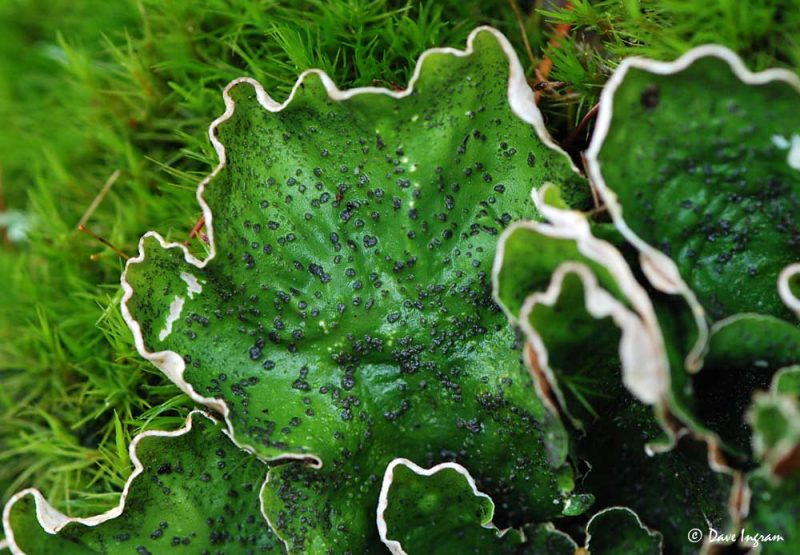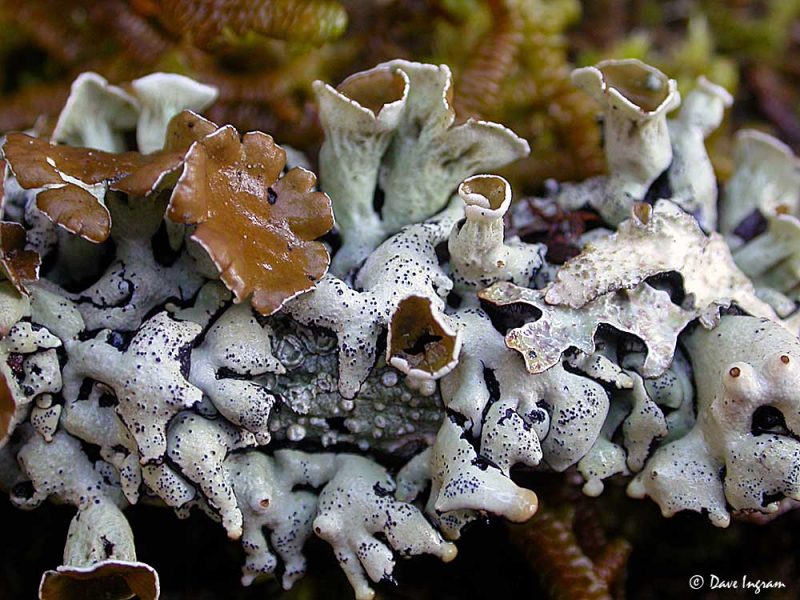Guest Post by Jocie Brooks

Most of us are familiar with the grey wispy lichens that garland tree trunks and branches. If you’ve been cross-country skiing at Mount Washington you’ve probably seen this stringy stuff that locals call “old man’s beard” or “witches hair” growing on tree trunks. Darker forms are known as “horsehair” or “bear’s hair.”
Lichens appear in a stunning array of colours, and may be yellow, orange, red, greenish, white, black, or grey. Varying greatly, they are classified by form into dust, crust, scale, leaf, club, shrub and hair. At least 1300 species of lichens have been identified in BC, and many areas have yet to be well documented. Anyone who discovers these organisms is sure to become enchanted with pixie cups, devil’s matchsticks, beaded bones, freckle pelts and more.

Lichen is a complex partnership between fungi and algae. When this relationship is forged an entirely new organism (lichen) is created. It is unique, and looks very different from fungi and algae that exist independently.
Fungi include mushrooms, moulds and mildews. In lichen relationships, most fungi belong to a group called the Ascomycetes, or sac fungi. Ascomycetes have tiny sacs that house microscope reproductive spores. The algal part of the relationship usually consists of green algae. However, some fungi pair up with cyanobacteria, formerly known as blue-green algae.
The fungal component (mycobiont) of the partnership makes up the main body of the lichen. On its own, fungi cannot produce its own food, and subsists on decayed matter such as rotting leaves and old logs. In lichen partnerships, however, fungi become dependent on their algae partners.
The algae or cyanobacteria component (photobiont) manufactures carbohydrates by using light energy the way all green plants do, by photosynthesis. In this mutually beneficial, or symbiotic relationship, the fungus gives the algae a protective home, and the algae/cyanobacteria provides the fungus with carbohydrates, vitamins and proteins.
BC’s lichen guru, Trevor Goward, describes lichens as “fungi that have discovered agriculture”. Goward aptly explains that lichens “are living greenhouses largely supported by carbohydrates derived from photosynthetic ‘crops’ growing within them.”

Typical leafy, or foliose lichens are comprised of sandwich like layers. The top surface layer is called the cortex. Beneath the cortex is the algae layer, which may be bright green. Under the algae is the fungus, which is white and thready. The undersurface is, again, the cortex, and it may have small holdfasts, or rhizines, that anchor the lichen to a surface.
Unlike flowering, or vascular plants, lichens are free-living and do not need to be rooted in soil. As long as light and moisture conditions are adequate, lichens can occupy a variety of niches including tree trunks and branches, rocks, and on the ground. Lichens are widespread, and can exist at high elevations, and climates that are both wet and dry.

Lichens reproduce by sexual and asexual means. Sexual reproduction involves a specialized structure called an apothecium, which is visible as a small disc or button on the surface of the lichen. The apothecia are lined with microscopic sacs containing spores.
Lichens also reproduce asexually, often via powdery granules called soredia. Soredia consist of minute fungal filaments intertwined with algae cells. Some lichens have tiny finger-like growths on them called isidia, which can break off and grow into new lichens. By using both sexual and asexual means of reproduction, lichens have adopted a successful strategy that has enabled them to exist for millennia.
Lichens play a valuable role in ecosystems. Lichens and mosses retain moisture and moderate humidity in forest ecosystems. When it rains, lichens absorb and retain a certain about of water, without which there would be increased run-off and erosion. Many lichens contribute significant amounts of nitrogen to forests when they decay on the forest floor.
Numerous animals depend upon lichen for nesting material and food. Large mammals, such as arctic caribou herds, feed primarily on Reindeer lichen in the winter months. Flying squirrels depend on a diet of beard lichens in the winter. The endangered Northern Spotted Owl preys upon flying squirrels, so the owl’s survival is linked to lichen. Many mammals, and many species of birds, use lichen as a nesting material. Humans use lichens for many purposes, including medicinal uses and dyes.
Lichen is a well-known indicator of air quality. Though lichens are widespread and common, few lichen species survive in urban areas. Studies have been conducted, using lichen, to determine degrees of air pollution. Lichens are abundant in wilderness areas, and many lichens are associated exclusively with old growth forests.
Some excellent books on lichen provide inspiring information and marvelous photography. “Lichens of North America” (2001, Brodo & Sharnoff) is a full sized coffee table book with over 900 colour pictures of lichens. For a field sized book “Macrolichens of the Pacific Northwest
” (1997, McCune & Geiser) is an excellent guide. “Plants of Coastal British Columbia
” (1994, Pojar & MacKinnon) offers sections on vascular plants, as well as mosses and lichens.
Looking at lichens makes any nature outing enjoyable and full of surprises. Lichens are most colourful when moist, so winter is a good time to discover these amazing organisms.